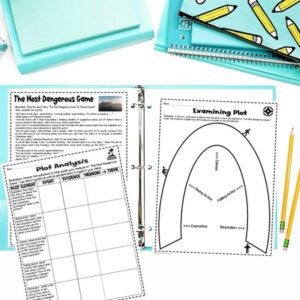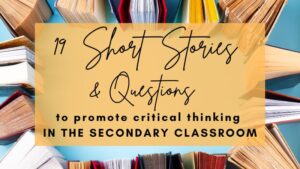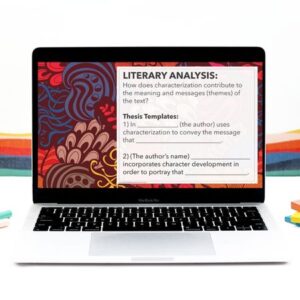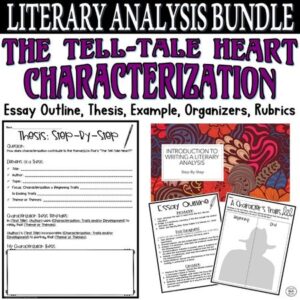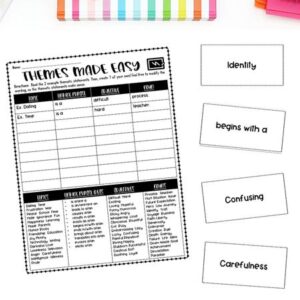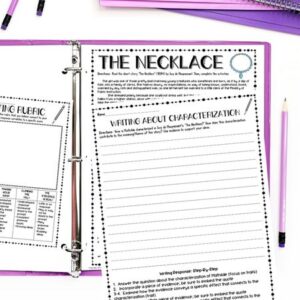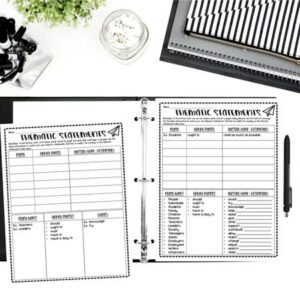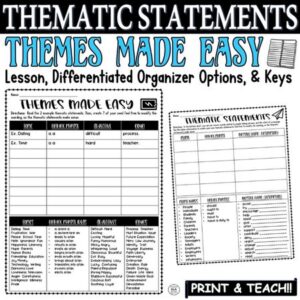Learning how to write a THEME STATEMENT is a real struggle for most students. You might think that because it is taught from kindergarten throughout the elementary years that understanding the message of a story, novel, or poem should be super simple to grasp. Unfortunately, it is most certainly not.
While shorter stories and fairy tales seem relatively easy to delve into when teaching about the theme, our students typically may not have the wherewithal to come up with a theme statement on the spot!
There is an important process we have to go through in order to accomplish this goal, and let me tell you, it can be an arduous journey over many, many years to truly comprehend how to develop a theme statement for ANY text a student reads. As texts become higher level in terms of language and ideas, we need to give our students the tools to critically analyze, discuss, and make assertions about what they have read.
Keep reading for ideas to help students create an effective theme statement!
Need help with Test Prep? Check out this FREE Pack of 3 Test Prep Activities to help students achieve success on standardized tests!

How to Write a Theme Statement Easily and Effectively in 5 Steps
1. Read the text with a focus on major ideas.
As you teach students how to write a theme statement, they will need some help BEFORE they begin reading. When we give students something to track as they read, they will be more successful in accomplishing the task set forth.
For example, if you are teaching theme and want to read “The Most Dangerous Game” by Richard Connell, you might encourage students to stop at the end of every page and discuss the major ideas and topics within.
HERE IS AN EXCERPT FROM THE FIRST PAGE:
“Don’t talk rot, Whitney,” said Rainsford. “You’re a big-game hunter, not a philosopher. Who cares how a jaguar feels?”
“Perhaps the jaguar does,” observed Whitney.
“Bah! They’ve no understanding.”
“Even so, I rather think they understand one thing–fear. The fear of pain and the fear of death.”
The characters discuss the following:
- hunting
- humanity
- animals
- death
- fear
- pain
Perhaps, you might give a small group certain ideas to track as they read; students can highlight, underline, and/or annotate textual evidence relating to these concepts throughout the story! By the end of the reading, they should have tons of evidence to examine in preparation for writing a theme statement!
Need teaching ideas, engaging activities, and critical thinking questions for short stories in the secondary ELA classroom? Click below!
2. Examine the textual evidence about the major ideas.
First of all, there is usually no one major idea within a piece of literature, let alone ONLY one theme. When students believe there is a perfectly crafted RIGHT answer, they become overwhelmed as they think it will be impossible to write a theme statement correctly.
So, we have to teach the concept of theme in a different way, and that starts by looking at the evidence!
If there is no evidence revolving around a certain message, there can be no theme statement.
Let’s look at the end of Edgar Allan Poe’s “The Tell-Tale Heart:”
They heard! — they suspected! — they knew! — they were making a mockery of my horror! — this I thought, and this I think. But anything was better than this agony! Anything was more tolerable than this derision! I could bear those hypocritical smiles no longer! I felt that I must scream or die! — and now — again! — hark! louder! louder! louder! louder! —
“Villains!” I shrieked, “dissemble no more! I admit the deed! — tear up the planks! — here, here! — it is the beating of his hideous heart!”
ANALYSIS OF THE EVIDENCE:
Obviously, we cannot trust the narrator by the end of this short story as he tells us right from the start that he is not “mad” or insane. This information, however, is quite hard for students to understand. The reader is told to trust the narrator’s mental capacity, yet his actions belie his true condition.
Because of the many contradictions throughout the story, we have to help our students dig deeply into the truth and make inferences about the evidence as they read.
Ex. “they were making a mockery of my horror!” —> Is this statement true? How are the investigators behaving?
Ex. “I could bear those hypocritical smiles no longer!” —> What does it mean to be a hypocrite? Are the investigators actually hypocritical? Why or why not?
Ex. “Villains!” —> Who is the true villain of the story? Why do you think this?
Before students can create a theme statement, they must be able to interpret at least some of the text, even if they only analyze specific sentences or excerpts. Modeling this process is key!
Check out this Literary Analysis Resource that helps students develop ideas about characterization and theme!
3. Introduce the Theme Statement Equation with examples.
There are several things you should consider before teaching the Theme Statement Equation.
- Make sure to remind students that a theme statement should be a complete sentence. A word or phrase will not do.
- There should be a connection to at least 1 major idea/topic from the text. While there is no exact theme, the major ideas should be evident and supported by the evidence.
- A writer, for the most part, intends a specific message or maybe even several messages. For this reason, I would encourage you NOT to use Reader’s Response Theory as a lens with which to view fiction or really any text. The audience’s feelings about what they have read mean very little when it comes to determining the actual meaning and message of a piece of literature.
THEME STATEMENT EQUATION
Major Idea + Topic Phrase = Theme Statement
The major idea should fit the text in some way, and the topic phrase should relay a message about the major idea.
Let’s say we are analyzing the end of the short story “The Necklace” by Guy de Maupassant:
- Pride
- Deception
- Humility
- Materialism
TOPIC PHRASE (MESSAGE ABOUT THE MAJOR IDEA):
- …leads to unexpected negative consequences.
- …creates situations that could have been avoided.
- …is usually only developed when one experiences extreme hardship.
- …can cause people to only focus on their own selfishness and ambition.
THEME STATEMENT EXAMPLES:
- Pride leads to unexpected negative consequences.
- Deception creates situations that could have been avoided.
- Humility is usually only developed when one experiences extreme hardship.
- Materialism can cause people to only focus on their own selfishness and ambition.
Need a week’s worth of easy-to-teach lessons for the short story “The Necklace” by Guy de Maupassant? Check it out HERE!
4. Practice writing a theme statement using previously taught texts and/or films.
Really, you can practice writing theme statements with ANY fictional and even some nonfictional texts! Messages, whether we like them or not, are EVERYWHERE.
Here are examples from various genres:
- Short Story “The Veldt” by Ray Bradbury: Consuming too much technology can lead to a superficial life.
- Film Seven Brides for Seven Brothers: People should be careful before making major life decisions.
- Poem “A Poison Tree” by William Blake: A vengeful heart can grow over time and lead to death.
- Play Romeo and Juliet by William Shakespeare: An unresolved conflict can cause unexpected and even deadly outcomes.
- Narrative “Roller Skating” by Kristin Menke: A summer childhood experience can have a lasting effect on someone’s outlook.
- Speech Give Me Liberty or Give Me Death by Patrick Henry: People who desire true freedom should be willing to give up their lives to attain it.
- Satire A Modest Proposal by Jonathan Swift: Those who cause the economic and cultural destruction of others should work to enact positive change when able.
If you need a FUN and easy way to teach students how to write a theme statement, click here!
5. Apply the Theme Statement Equation to the new passage.
Before requiring students to write a theme statement on their own, you could perhaps allow students to work in small groups or pairs. It can be intimidating to create a theme statement for the very first time.
After students create their initial thematic statements, there are several things you might do to help students edit, revise, or redo their theme statements.
- Trade theme statements between several groups and encourage POSITIVE critiques with helpful advice.
- Read aloud GOOD EXAMPLES from various students to help others get ideas.
- Play 4 Corners with the theme statements; it provides an opportunity for discussion!
- Ask students for specific textual evidence to back up their theme statements or locate evidence for other groups’ theme statements!
Although developing a theme statement strategy can be tough at times, we need to consistently teach, review, and reteach how to write a theme statement as every year the texts increase in complexity. We must prepare our students for the inevitable standardized test they will take, for college courses that will require critical thinking skills on a daily basis, and for ANY text they will encounter throughout their lives!
Perhaps, their lives could even provide opportunities to write a theme statement!
Ask yourself and your students: What message do you want to convey about your life?
THEME STATEMENT RESOURCE:
Do you need FUN and ENGAGING ways to introduce writing thematic statements? Check out this Theme Graphic Organizer Pack that focuses on writing THEMES / THEMATIC STATEMENTS!
These activities will help your students prepare to write theme statements in varied formats like poetry, short stories, plays, narratives, and novels!
JUST PRINT & TEACH!
Need more help with teaching how to write a theme statement for short stories, poems, and other texts? Check out my store Kristin Menke-Integrated ELA Test Prep!


